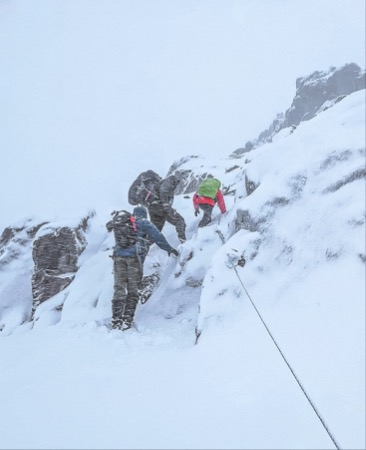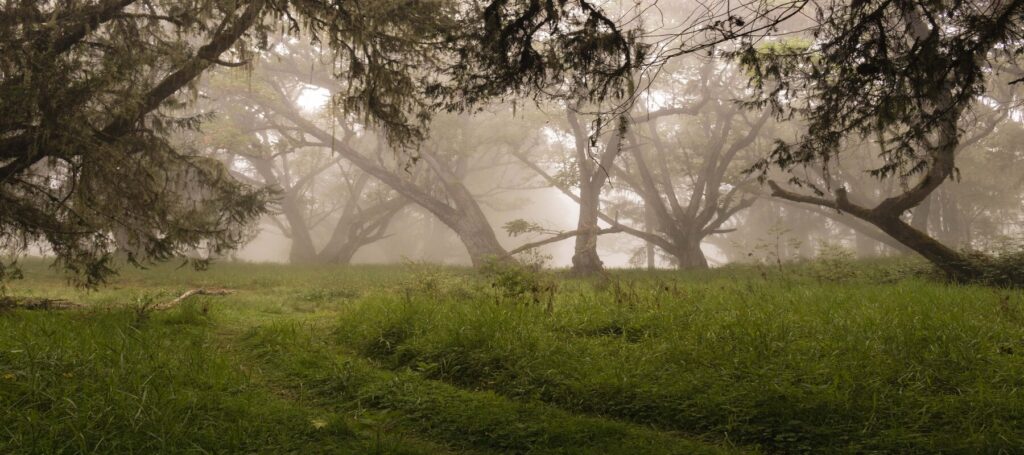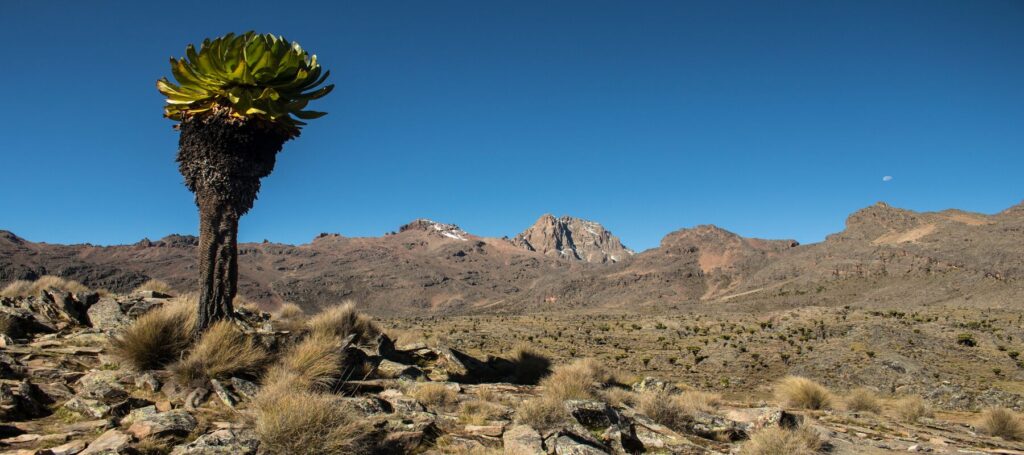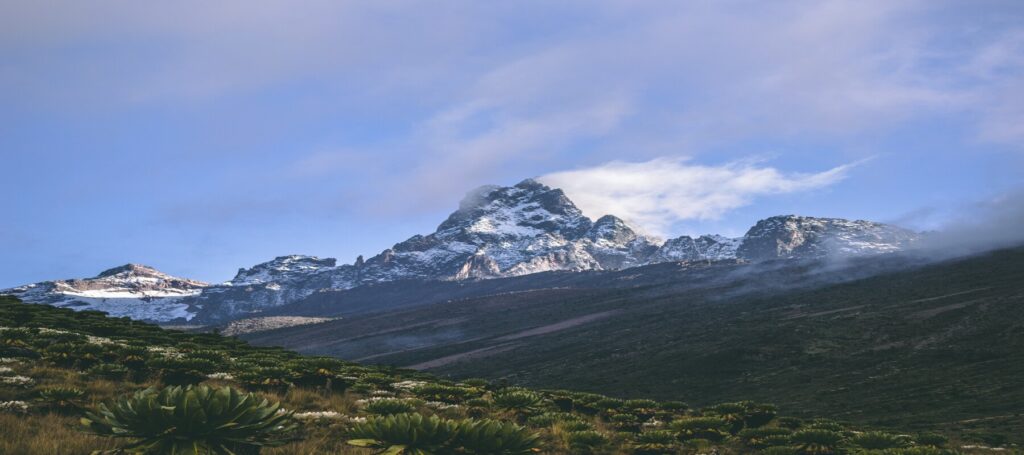Etched into the wooden bedframe above me are the words: ‘only a hill, but all of life to me, up here, between the sky and the sea’. These sentiments tie into my thoughts of how lucky I am to be here, climbing a mountain, when almost all travel has been banned for the last eight months.
I attempt to fall asleep in an effort to gain as much energy as I can for our summit push in a few hours, but find it difficult at a core-chilling -10°C. In the meantime, I’m enjoying one of the most spectacular shows that I have ever witnessed. The wooden hut that I’m lying in, built by the Austrians in 1973, sits on a small plateau at an altitude of 4,790m (15,715ft) surrounded by a fortress made up of the three highest peaks in Kenya. Batian, the second tallest peak in Africa, stands majestically against a clear, midnight carpet of an infinity of stars. These cloudless skies aren’t unusual in Africa but below us, giant, towering cumulonimbus grow so high the tops reach our level, lighting up the snow-capped peaks above with their lightning storm.
It has taken us and a team of seven, led by our 25-year-old guide Andrey Josephs – known as Joe – five days to reach this point. Joe has Mt Kenya ingrained within him. He tells me that, as a child, he’d walk to and from school, his eyeline pointed upwards daydreaming over the dramatic peaks. Joe’s father, Paul, is also part of the team, himself a lead guide of the mountain for decades. On this trip he’s designated team cook and produces delicious meals from food and equipment carried by the rest of us – with the odd trout that he catches from the glacial lakes found above 4,000m.

The plan is to reach the summit before sunrise, so it is necessary to start the 300m ascent in the pitch black of the early hours. I open the door of the Austrian Hut at 4am, in shock to be greeted not by the clear starry skies of a few hours ago but by knee-deep snow and a horizontal blizzard. Paul appears from around the corner with a grin on his face, ‘I haven’t seen conditions like this since the early 90s!’ It takes me a few moments to realise that we are still going, right now, and shortly after four head torches point towards the ridgeline, piercing through the shower of white, falling from all directions.
The route that we could clearly make out the day before is now completely indistinguishable below the mass of snow. Unperturbed, Paul heads in front carefully testing each step, navigating the terrain like the back of his hand. Every now and then his foot sinks thigh-deep into the snow, with a chuckle of enjoyment, clearly revelling in the morning’s conditions.
The fixed ropes have disappeared well beneath the snow, making the climb incredibly challenging – having to haul ourselves up steep cliffsides with nothing to hold on to, balancing on sheets of snow that continually slip away from under us. I would never have dreamt of being in these sorts of conditions so close to the Equator. The snow was falling so hard that each flake stung my face – the only way to continue was to keep looking downwards with the odd glance up to make sure we were heading in the right direction. Every footstep was hard work, but I found myself smiling and couldn’t help but think, this is awesome!
After two hours we reached the Lenana summit. Last night, Joe told us that on a clear day we would be able to see Kilimanjaro in Tanzania from here. Today I could see only about 10m in front, but for some reason I felt even luckier than those who had gazed upon Africa’s highest point. Yesterday, as we hit 4,500m and the snow started falling, Daniel – one of our porters, 60 years old and self-professed technology illiterate – sat trying to work out how to take a selfie with his old Nokia phone, attempting to capture himself with the snowy background. ‘I’ve never once seen him take a selfie in almost 20 years,’ says Joe. ‘He can’t believe he’s seeing Mt Kenya like it was before – no-one thought it was possible to see snow like this anymore.’ I was just beginning to really appreciate sharing this moment with the team.
***
I have trekked many mountainous regions, including the Himalayas and the Alps, but never have I come across anything like Mt Kenya, the topography of which changes dramatically even with the slightest increase in altitude. Millions of years ago, the dense rainforests that stretch across the DRC and Uganda reached Mt Kenya. These have since retreated thousands of miles, leaving just a small area around the lower levels of the mountain. This is exactly what I imagine a prehistoric jungle to look like: colossal African redwood trees grow so tall, their snake-like vines drape from a canopy so thick that only a handful of sun beams can penetrate.

Elephants and leopards still live here but, with a decreasing population, they ’re extremely difficult to find. Joe shows me a photo of a leopard that he caught on camera in March, much larger and more muscular than its slender, savannah cousins. Only a few days later we pass through Alpine tundra, where no trees grow but peculiar cabbage groundsel – a spiky, shrub-like plant – takes the stage. The plant’s thick leathery leaves close up to protect its inner bud during the sub- zero night temperatures.
Joe is from the Nanyuki tribe, who have lived on the lands surrounding Mt Kenya for thousands of years. Although ancient traditions and ways of life still exist, the last half a century has seen a dramatic change to the landscape of the mountain. From the 1970s, Mt Kenya suffered almost three decades of deforestation to pave settlements for the rapidly growing population. This altered the climate of the area (along with global climate change), and the mountain once known as ‘white-capped’ Mt Kenya – marketed by the British in the early 1900s as an ‘exotic ski destination’ – permanently changed.
Most of its glaciers have now completely melted. The largest, Lewis Glacier, is currently 90% of its original size and is predicted to disappear within the next ten years. Nowadays Joe can’t even safely tell his clients what to expect. The rainy seasons sometimes go for weeks without rain and the non-rainy seasons can rain non-stop for days. The amount of snow we experienced hadn’t occurred for decades. On our second day we fell victim to the unpredicted continuous rain, which consisted of a heavy downpour over several hours. Rivers had overflowed to the extent that we had to pull down trees to make crossings usually jumped across, and dry dirt paths used to climb up the mountain turned into a succession of streams and small waterfalls.

There was one positive from the unexpected rain, however: it forced us to camp for two nights on the shores of Lake Michelson to give our drenched kit time to dry off. We couldn’t have been more fortunate. This stunning glacial lake, sat just above 4,000m, is framed by volcanic rock precipices, hundreds of metres high, dating back three million years. The lake is so deep that a helicopter is said to be lying on the bed, too far below the surface for divers to even gauge the depth. Our day off was spent exploring the nearby caves that formed natural and refreshing showers, fishing trout for lunch, hiking waterfalls and sat around the campfire. One of the team even swam in the lake, shortly emerging a rare human shade of purple – one stage away from hypothermia.
Joe loves the mountain and it’s easy to understand why. He’s seen the continuing effects of climate change, both caused by local and global factors, and he’s passionate about educating others about the importance of the delicately balanced two-way relationship between humans and our ecosystems. ‘The rainfall caused by deforestation has been so heavy and continuous this year that it’s caused flooding, landslides and subsequently displaced numerous families from their homes,’ he tells me.
The Covid-19 pandemic hasn’t helped, with tourism in Kenya dropping by over 90% in 2020. As a consequence, money coming into conservation has also decreased. The one silver lining, however, is that for the first time Kenyans are beginning to visit the mountain in large numbers, and are witnessing first-hand the importance of climate change in their own country. As Joe continues to explore himself, he lectures and works with charities to teach people, especially children, on how their small actions can have a huge impact.

Just nine hours after summiting we’re back in the thick warmth of Kenya’s lower altitudes – down jackets swapped for t-shirts and waterproof boots for flip flops. We’re all sat around a table enjoying barbecued lamb kebabs. I look around at the beaming faces of the team, emotions that I know are unusually elated. Each of them can’t wait to get back to their families to tell them about the last few days, and – more importantly – that we should be doing everything that we can to protect our planet.
Geri Moore is an airline pilot and avid traveller. She regularly contributes to various travel publications focusing on remote travel, with a special interest in ethnic culture, wildlife and conservation.